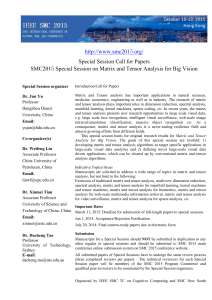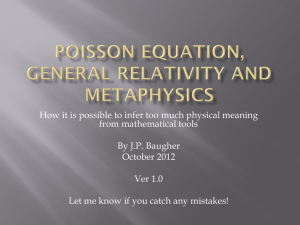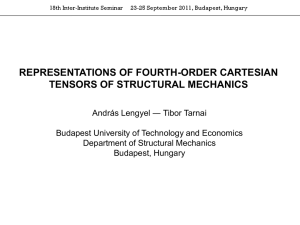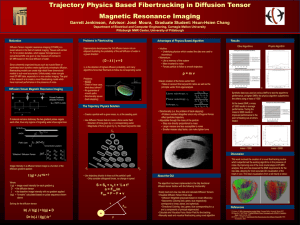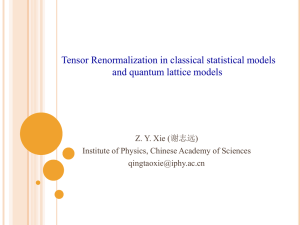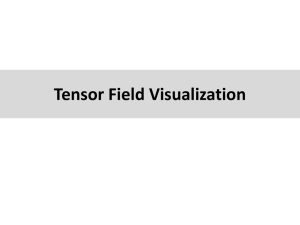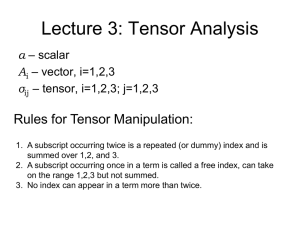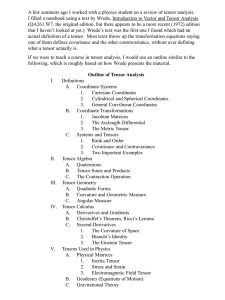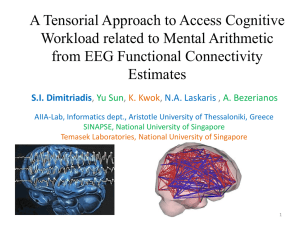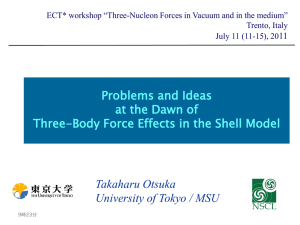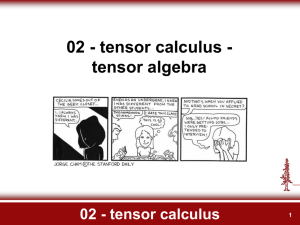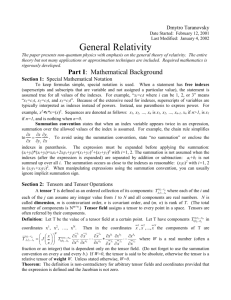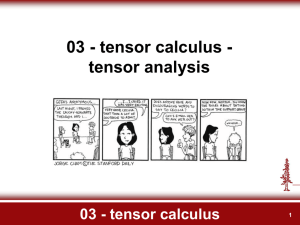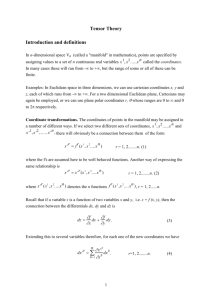pptx - of Marcel Ritter
advertisement
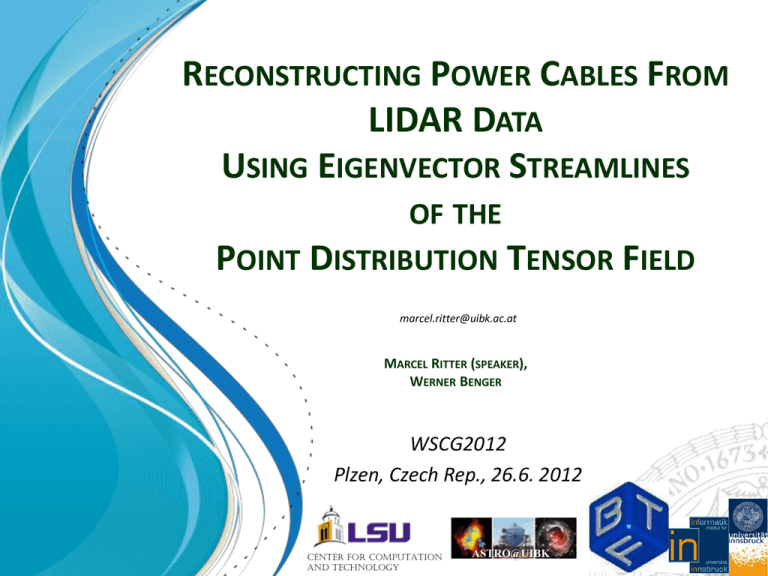
RECONSTRUCTING POWER CABLES FROM LIDAR DATA USING EIGENVECTOR STREAMLINES OF THE POINT DISTRIBUTION TENSOR FIELD marcel.ritter@uibk.ac.at MARCEL RITTER (SPEAKER), WERNER BENGER WSCG2012 Plzen, Czech Rep., 26.6. 2012 Center for Computation and Technology ASTRO@UIBK Overview • Motivation • Methodology – The Point Distribution Tensor – Weighting Functions – Eigenvector Streamlines • Implementation and Verification – Comparison Meshfree/Uniform Grid – Test Cases • Application • Conclusion and Future Work Motivation • Arose from an airborne light detection and ranging (LIDAR) application • Earth surface scanned by laser pulses point cloud Motivation • LIDAR point cloud: Motivation Reconstruct linearly distributed points of the LIDAR laser scan as lines Power cable detection applicable for companies to maintain power lines Alternative method to current approaches Motivation • Based on previous work – Direct visualization of the point distribution tensor – Streamline integration – Inspired by diffusion tensor fiber tracking Point Distribution Tensor Field [RBBPML12] Streamlines Methodology • Computing the point distribution tensor Methodology • Tensor analysis: – Shape factors by [Westin97] – S(Pi) is a 3x3 symmetric tensor and positive definite – 3 Eigen-Values: – Shape factors: [BBHKS06] Methodology • Tensor visualization: – Ellipsoids representing the shape factors – Tensor Splats [BengerHege04] -> barycentric [BBHKS06] Methodology • Tensor Splats of a rectangular point distribution Points Tensor Splats Methodology Distribution tensor of airborne LIDAR data Methodology • Weighting functions: – 7 different weighting functions were implemented Methodology • Weighting functions: Methodology • Influence of weighting on the resulting tensor 𝜔1 𝜔2 Distribution tensor and its linearity of a rectangular point distribution Methodology • Influence of weighting on the resulting tensor 𝜔3 𝜔4 Distribution tensor and its linearity of a rectangular point distribution Methodology • Influence of weighting on the resulting tensor 𝜔5 𝜔6 Distribution tensor and its linearity of a rectangular point distribution Methodology • Influence of weighting on the resulting tensor 𝜔7 Distribution tensor and its linearity of a rectangular point distribution Methodology • Streamlines – Common tool for flow visualization – Curve q on Manifold M with s the curve parameter – Vector field v with Tp(M) an element of the tangential space at point P on M – Streamline as curve tangential to the vector field Methodology • Eigen-Streamlines – Must be able to follow against the vector field Tensor Streamline Valid major eigenvectors Eigen-Streamline Implementation and Verification Implemented in the VISH visualization shell Allows to implement visualization modules C++/OpenGL/OpenCL 2 Eigen-streamline modules Uniform/Curviliear grid Distribution tensor module extended by the weighting functions Network of modules Meshfree grid Implementation and Verification Eigen-streamline module KDTree for neighborhood search • All vectors are aligned to the direction of the first vector in the neighborhood • Interpolation of the vector is done using one of the weighing functions The Eigen-vector is reversed when the dot product to the last tangent vector is negative C++ templates used to switch weighting functions Implementation and Verification • Verification of Meshfree Approach – Eigenvector field of MRI brain scan, [BBHKS06] – Converted uniform grid data to meshfree grid – Compare streamlines computed on both grids Implementation and Verification • Verification of Meshfree Approach – Trilinear interpolation on uniform grid – ω2 slinear interpolation on meshless grid – 81% of 144 short streamlines coincide well Meshfree Uniform Grid Implementation and Verification • Circle Integration – Tested numerical integration schemes Explicit Euler Explicit Euler DOP853 (Runge-Rutta order 8) Implementation and Verification • Rectangle Integration – Tested different weighting functions for vector interpolation – Horizontal distance of integration start to endpoint as error measure Implementation and Verification • Error of rectangle reconstruction integration Application • LIDAR cable reconstruction Application • LIDAR cable reconstruction Application • LIDAR cable reconstruction – Manual seeding position and direction – Tested 41 different combinations of different weighting functions and neighborhood radii • Tensor computation (r = 0.5, 1.0, 2.0 [m]) • Vector interpolation (r = 0.25, 0.5, 1.0, 2.0, 3.0 [m]) Tensor computation with 𝜔3 ,r=2.0, and interpolation with 𝜔7 , r=3.0, worked best in this scenario Reconstructed 280m of cable with an error of 80cm Application • LIDAR cable reconstruction Tensor 𝜔1,r=2, DOP853 Eigen-streamlines 𝜔3,r=1 Tensor 𝜔3,r=2, DOP853 Eigen-streamlines 𝜔7,r=1 Conclusion Computed Eigenstreamlines in a mesh free point distribution tensor field Verification on simple test geometries Reconstructed a power cable • LIDAR dataset • 280m cable Future Work Investigate other weighting functions and weighting combinations • Automatically find an optimal combination of weightings Investigate other data sets Improve seeding automatic seeding Do not follow Eigen-vectors in non linear regions Better interpolate tensors directly and not Eigen-vectors during integration Integrate in 2 directions simultaneously from given seeding point References [RBBPML12] Ritter M., Benger W., Biagio C., Pullman K., Moritsch H., Leimer W., Visual Data Mining Using the Point Distribution Tensor, IARIS The First International Workshop on Computer Vision and Computer Graphics VisGra 2012, February 29 - March 5, 2012 - Saint Gilles, Reunion Island, France [Taubin95] G. Taubin, “Estimating the tensor of curvature of a surface from a polyhedral approximation,” in Proceedings of the Fifth International Conference on Computer Vision, ser. ICCV ’95. Washington, DC, USA: IEEE Computer Society, 1995, pp. 902–. [Westin97] C. Westin, S. Peled, H. Gudbjartsson, R. Kikinis, and F. Jolesz, “Geometrical diffusion measures for MRI from tensor basis analysis,” in Proceedings of ISMRM, Fifth Meeting, Vancouver, Canada, Apr. 1997, p. 1742. [BengerHege04] W. Benger and H.-C. Hege, “Tensor splats,” in Conference on Visualization and Data Analysis 2004, vol. 5295. Proceedings of SPIE Vol. #5295, 2004, pp. 151–162. [BBHKS06] Benger, W., Bartsch, H., Hege, H.-C., Kitzler, H., Shumilina, A. & Werner, A. (2006). Visualizing Neuronal Structures in the Human Brain via Diffusion Tensor MRI, International Journal of Neuroscience 116(4): pp. 461–514. Marcel Ritter 1) Werner Benger 2,3) 1) Institute for Basic Sciences in Civil Engineering, University of Innsbruck, Austria 2) Center for Computation & Technology, Louisiana State University, Baton Rouge, USA 3) Institute for Astro- and Particle Physics, University of Innsbruck, Austria
